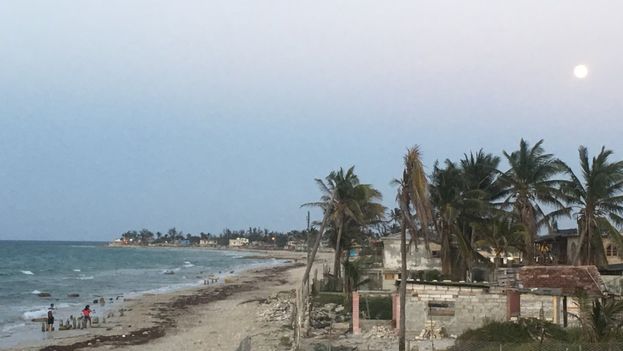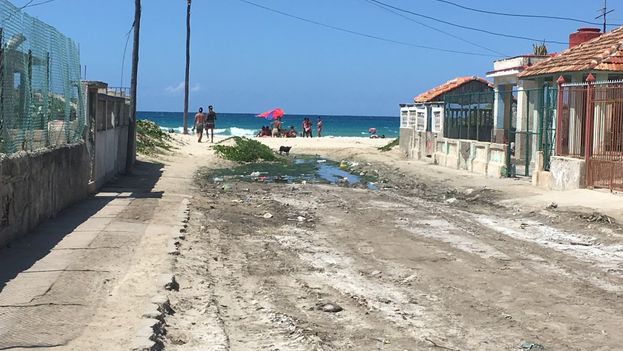
![]() 14ymedio, Havana, 2 April 2018 — The perimeter wall has a concrete reinforcement every two yards. “Even with this we can’t stop the sea,” says Elsa, a retiree who lives 50 yards from the coast, in La Conchita, east of Havana. “Here the fight is hard, either the waves destroy us or [Samuel] Rodiles destroys us,” she laments, referring to the president of the Institute of Physical Planning (IPF).
14ymedio, Havana, 2 April 2018 — The perimeter wall has a concrete reinforcement every two yards. “Even with this we can’t stop the sea,” says Elsa, a retiree who lives 50 yards from the coast, in La Conchita, east of Havana. “Here the fight is hard, either the waves destroy us or [Samuel] Rodiles destroys us,” she laments, referring to the president of the Institute of Physical Planning (IPF).
The town of Guanabo is the scene of a silent war being fought between three sides: the sea, the government and residents. At night, waves splash the windows of the buildings on the beachfront. At dawn a trail of debris represents the structures that failed to resist.
Every day that a front gate doesn’t end up under water or receive a demolition order is a victory for the residents of this tourist area, who fear both the advance of the tide and the IPF, led by General Samuel Rodiles Planas, a man of the old guard to whom Raúl Castro has entrusted the task of bringing order to the country’s urban and housing chaos.
Since Rodiles took office in 2012, he has waged a tough battle against homes located very close to the sea under the slogan of “restoring legality in the coastal zone.” On the beaches of eastern Havana new constructions, extensions or the remodeling of houses that are less than 200 feet from the edge of the sea are forbidden.
The denunciations and the inspectors have become a nightmare for those who live in that strip of coastline, with white sands, which begins in El Mégano, passing through the more elitist Santa María del Mar, the familiar Boca Ciega or the deteriorated Guanabo, until you reach the farthest Jibacoa.
The restrictions imposed by Rodiles seriously affect those residing in the area who make a living from renting rooms to domestic and international tourists. “They give us loans to buy construction materials, but then they do not give us permission to improve our homes,” explains Jorge Marrero, who holds a “self-employment” license allowing him to rent two rooms.
“What many residents are doing is remodeling in secret, little by little and without much notice, so the inspectors won’t show up,” he says. The landlord maintains that “there is an interest in moving all Cubans who live close to the water, to put those areas under state ownership,” he says.

Cuba could lose over a thousand square miles of land and several thousand homes by the year 2050 due to the rise in sea level, which is expected to total over 10 inches by that time, according to statements to the official press by the director of the National Agency of Environment, Tomás Escobar.
This situation “will increase the vulnerability of coastal settlements, reduce forest and crop areas, and the quality and availability of water,” the specialist points out. Among the most affected areas are the north coast areas of the provinces of Matanzas, Havana, Mayabeque and Artemisa.
In Guanabo, east of the capital, Elsa has hired a team of masons who on Tuesday will reinforce the wall that separates her house from the sand, where the sargasso is piling up. “There are days that I’ve woken up with people sleeping in the doorway because they think this is a public part of the beach,” she says.
In 2017 the Council of Ministers approved a State Plan to confront climate change. The Minister of Science, Technology and Environment, Elba Rosa Pérez Montoya, warned that climate change “will aggravate environmental problems, becoming a determining factor in sustainable development.” But the package of official measures also has a dark side.
“They show up and tear down everything that is close to the coastline, it doesn’t matter if it is contained within a property,” Elsa says, complaining about the performance of the IPF. “When I was born the beach was much farther away and it is not our fault that now it’s in the patio,” she reflects. But every year, the waters have continued to enter the settlement at a speed difficult to ignore.
The IPF relocates people to other areas, but the task is complex because it is estimated that in the country there are more than 35,000 people in vulnerable conditions and more than 11,000 homes affected by the rise of the water.
In La Conchita, several residents who live with their doorways right on the beach have been pressured to move “inland,” a vendor of guava cakes in the area, who preferred anonymity, tells this newspaper. “They want to put us in buildings that look like matchboxes, but we were born and grew up with the sea in front of us.”

The home of the small merchant shows serious effects on “the foundations and the walls closest to the water, but nobody in my family wants to move,” he says. “We are going to stay to pressure them and make them offer us something better, also near the sea.”
According to scientific studies, the climate of the island is warmer every year. In the last 17 years the country has suffered nine intense hurricanes and it is estimated that the sea level has risen rapidly. It doesn’t take a scientist to realize: “The water is coming into the living room of the house,” explains Rogelio, owner of a house that he rents tourists in the area of Boca Ciega.
“Years ago we lost the wooden bridge that joined Boca Ciega with Santa María because the sea destroyed it, but no state work brigade has come to repair it,” he complains. Rogelio believes that “the great disinterest in fixing the place is because they want to get us out and make all this the property of the State.” He believes that “they are going to give this to foreign firms to build hotels, as they did in Varadero.”
For many residents in the lower areas of this coast, there is “a coincidence between what the Government wants and what the sea wants: to get us out of here,” says Rogelio, who sees in the official neglect when it comes to repairing infrastructure like streets and sewers, a way to “push people to leave.”
The avenues of Guanabo are full of gaps at the corners, where there once was a sewer system, but the streets that run into the sea have been lost under the sand and the supply of brackish water is unstable.
The options for neighbors who choose to relocate are uncertain. “There are people who had mansions near the sea and now they’re suggesting that they live inland in buildings without many amenities,” says the retiree.
Some prefer to stay and resist. “Nothing can be made with iron because the saltpeter causes it to fail and damage everything around it,” says Geondys, a 28-year-old bricklayer who works on several of the houses in the area. “This, more than masonry is just makeup, because these houses have to be refurbished every month to be maintained.”

Geondys’ specialties are the perimeter walls, the external showers for customers to clean the san off before entering the house and the installation of moderately hermetic windows that stop mosquitoes, saltpeter and the invasion of strangers that in the summer months become more reckless with the houses that are closer to the sea.
“I make a living from this, so what for many is a problem for me is a way to support my family,” says Geondys. “The sea puts food on our table.”
Others, like the owners of the restaurant Le Mare try to take advantage of the waves that get closer and closer. “Customers like to eat on our deck because it’s like they’re on a pier over the sea,” an employee told 14ymedio, from the premises with several tables facing the immense blue. “Hold onto your napkins,” he warns each diner to prevent them being blown away by an onslaught of the sea breeze.
A small fence separates Le Mare from the sand where three catamarans offer trips in the area to those who want to mix a lobster with maritime pastimes, or a beer with some adrenaline on the tide. The boats are private and charge around 5 CUC for a short ride. “The proximity of the water to the houses benefits us, because this way the clients are closer,” says one of the pilots.
The man, who defines himself as “catamaran champion and expert on the Havana coastline,” recalls a time when the terrace of Le Mare was not an arm’s length away. “There was a time when we were out of this, now we live surrounded by water.”
_________________________
The 14ymedio team is committed to serious journalism that reflects the reality of deep Cuba. Thank you for joining us on this long road. We invite you to continue supporting us, but this time by becoming a member of 14ymedio. Together we can continue to transform journalism in Cuba.
